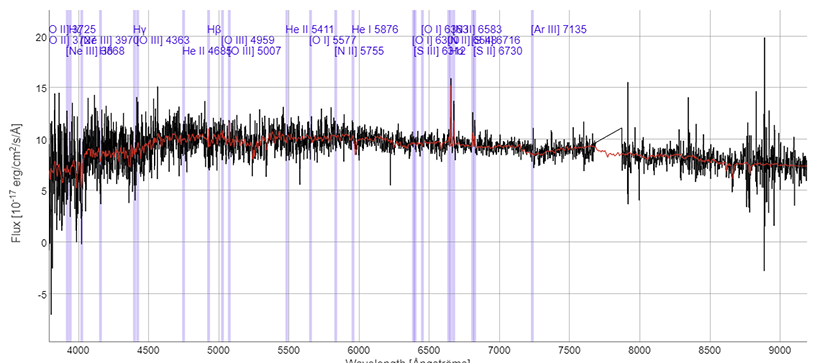Optical Spectra Overview
Data Release 16 includes the complete dataset of optical single-fibre spectroscopy of the Sloan Digital Sky Survey through February 2019. These data represent the culmination of SDSS 20 year mission in collecting optical spectra to map the 3D structure of the Universe. SDSS-IV eBOSS was the final stage.
In all, more than four million spectra comprising extra-galactic and galactic spectra are available. SDSS optical spectra, both galactic and extra-galactic, are organized into a number of component surveys. The information boxes below describe the surveys that use SDSS single-fiber optical spectra to study both environments, with links to more information on each.
SDSS optical extra-galactic observing programs
- The extended-BOSS (eBOSS) (including TDSS and SPIDERS, SDSS-IV)
- The Sloan Extended Quasar, ELG, and LRG Survey (SEQUELS) (SDSS-III/-IV)
- The Baryon Oscillation Spectroscopic Survey (BOSS) (SDSS-III)
- Supernova Survey (SDSS-II)
- Legacy Survey (SDSS-I/II)
A brief summary of these extra-galactic observing programs is given on the Extra-galactic Observing Programs page.
For the Integral Field Unit (IFU) spectra observed by the Mapping Nearby Galaxies at APO (MaNGA) survey, see MaNGA Overview.
SDSS optical Milky Way observing programs
- The Time Domain Spectroscopic Survey (TDSS) (SDSS-IV)
- The Sloan Extension for Galactic Understanding and Exploration (SEGUE) (SDSS-II/-III)
- The Multi-object APO Radial Velocity Exoplanet Large-area Survey (MARVELS) (SDSS-III)
- Legacy Survey (SDSS-I/II)
For the infrared-wavelength Milky Way spectra observed by the Apache Point Observatory Galaxy Evolution Experiment (APOGEE), see the APOGEE Overview page.
For the MaNGA Stellar Library (MaStar), see MaStar Overview.
Get the Data: Spectroscopic Catalogs
SkyServer
All spectroscopic catalog data is available through the search tools of SkyServer. The Spectroscopic Query Form lets you search for spectroscopic catalog objects by position, spectral classification, redshift, and other constraints in spectroscopy and imaging. SQL Search lets you create your own search; see the SkyServer SQL Tutorial to learn how to write SQL queries.
CasJobs
An even more flexible and powerful interface is CasJobs, which allows you to save and analyze all your search results.
Get the data: FITS spectra
Science Archive Server (SAS)
The Science Archive Webapp provides a searchable interface for optical spectra, and includes an interactive spectrum viewer, and a data download facility (supports both rsync and wget):
More information about SDSS spectra
- Understanding SDSS spectra:
- describes how SDSS spectroscopic data are organized, and the various spectroscopic observing programs that compose the full SDSS.
- Pipeline:
- describes the steps in
the spectroscopic data processing, and the files created at each step. - Available data:
- describes in detail what spectroscopic data products are available through the Science Archive Server and SkyServer.
- Target flags:
- describes how to track the way in which a spectrum was chosen (targeted) for spectroscopic follow-up.
- Spectroscopic catalogs:
- describes the parameters available in SDSS spectroscopic catalogs, such as redshifts and classifications.
- Galaxies:
- describes additional galaxy parameters calculated from SDSS spectra.
- Stars (SSPP):
- describes the SEGUE Stellar Parameter Pipeline, which estimates stellar atmospheric parameters, and how to use SSPP data.
- SEGUE SQL cookbook:
- describes getting stellar parameters out of the SQL database, with examples.
- Caveats:
- describes some important caveats in using SDSS spectroscopic data, including how to check data quality.
To learn how the SDSS chose objects for spectroscopic observation, see the SDSS Target Selection pages.



